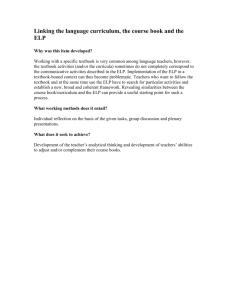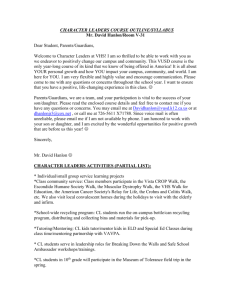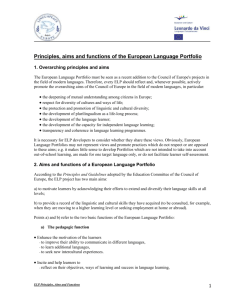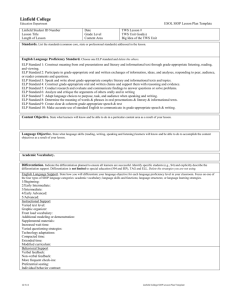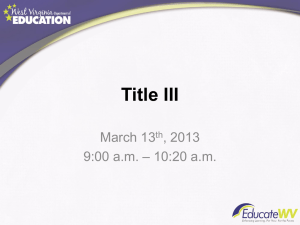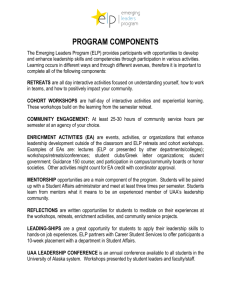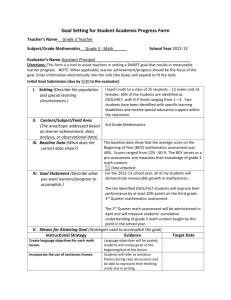Principles and Guidelines
advertisement
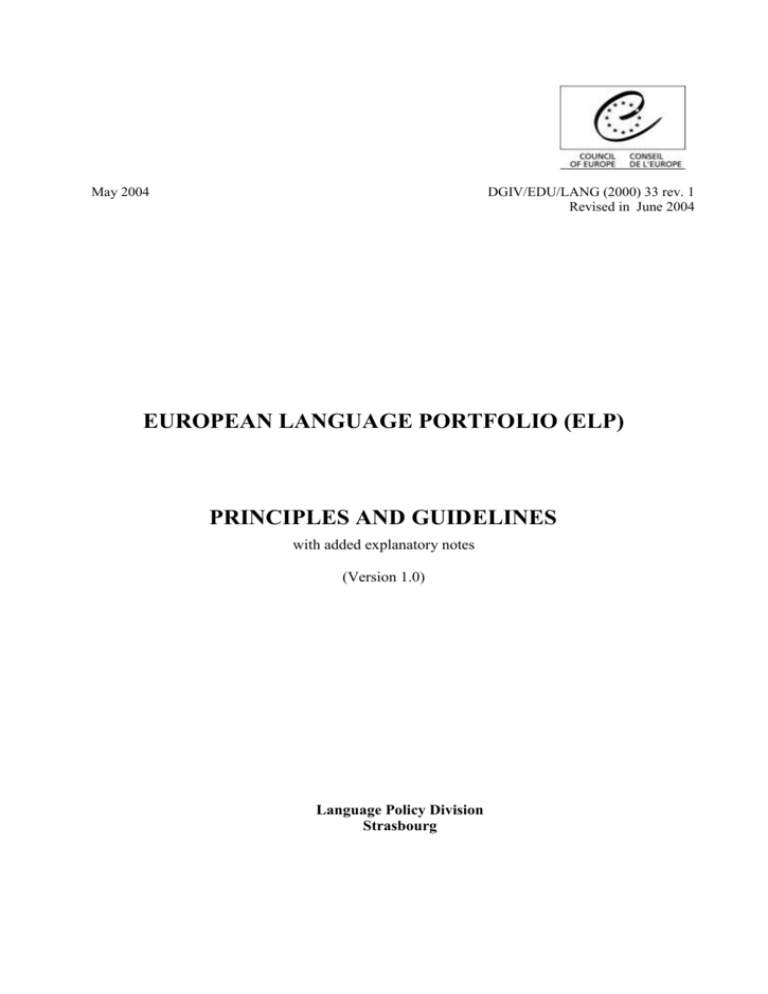
May 2004 DGIV/EDU/LANG (2000) 33 rev. 1 Revised in June 2004 EUROPEAN LANGUAGE PORTFOLIO (ELP) PRINCIPLES AND GUIDELINES with added explanatory notes (Version 1.0) Language Policy Division Strasbourg PRINCIPLES AND GUIDELINES In this document the left hand column contains the Principles and Guidelines that have been in use since 2000 and remain mandatory as regards the design and validation of ELPs. The right hand column contains explanations and commentary designed to assist ELP developers. In the interest of – the quality and credibility of the European Language Portfolio as a pedagogic and reporting tool and of – the quality, validity and transparency of individual ELPs in a European context authorities, decision makers, ELP developers, teachers and learners will use their best endeavours to follow these Principles and Guidelines when creating, using and promoting the European Language Portfolio. 1. The ELP reflects the Council of Europe’s concern with: 1.1 the deepening of mutual understanding among citizens in Europe; 1.2 respect for diversity of cultures and ways of life; 1.3 the protection and promotion of linguistic and cultural diversity; 1.4 the development of plurilingualism as a life-long process; Increasingly the individual’s language learning needs are likely to evolve over a lifetime in response to educational, vocational/professional and individual/social requirements. 1.5 the development of the language learner; The Council of Europe is committed to the development of learner autonomy as one of the cornerstones of education for democratic citizenship and lifelong learning; hence the ELP is designed to help learners to achieve a fuller awareness of their developing linguistic and cultural identity. 1.6 the development of the capacity for independent language learning; The ELP is likewise designed to help learners to achieve a fuller awareness of themselves as language learners and to develop language learning skills that they can deploy to meet individual needs that arise outside as well as inside formal educational contexts. These three paragraphs refer to principal goals of the Council of Europe and explain why each ELP should have a strong European identity; foster cultural and linguistic diversity; promote intercultural learning and the development of intercultural awareness and intercultural competence; help language learners to recognize and participate in the linguistic and cultural diversity that is central to their European heritage. 2 1.7 transparency and coherence in language learning programmes; Transparency and coherence are key principles underlying the Common European Framework. When they are transferred to the ELP they imply that each ELP should be coherent in its structure and fully self-explanatory. Structural coherence includes consecutive page numbering. The principles of transparency and coherence also imply that ELPs should be designed in such a way that they help learners in formal educational contexts to understand the purpose and direction of the language learning programmes they are following. 1.8 the clear description of language competence and qualifications in order to facilitate mobility. The validity of the ELP’s international reporting function depends on its use of the common reference levels of the Common European Framework. 2 The ELP: 2.1 is a tool to promote plurilingualism and pluriculturalism; The ELP is designed to take account of all of the learner’s language and intercultural learning, whether it takes place inside or outside formal educational contexts. Accordingly ELPs should provide space for recording (i) all experience of learning and using second/foreign languages and (ii) competence in a number of languages. As a general rule ELPs should not support the learning of only one language. However, an exception has been made in the case of ELPs designed for use by migrants learning the language of their host community, though these are still required to take account of other languages the learner uses. 2.2 is the property of the learner; This means that the individual learner owns his/her ELP in both a literal and a metaphorical sense. Whatever support may be provided by educational institutions and teachers, the individual learner is responsible for maintaining his/her ELP. This entails responsibility not only for the ELP as a physical object but for all the processes that ELP use requires. In particular, the individual learner is responsible for the regular self-assessment that is fundamental to effective ELP use. This will generally require guidance appropriate to the target age group of the ELP model in question. 2.3 values the full range of the learner’s language and intercultural competence and experience regardless of whether acquired within or outside formal education; In many cases learners develop competence in languages and cultures that do not form part of their formal educational experience. The ELP should help them to recognize and record this. 2.4 is a tool to promote learner autonomy; See also 1.5, 1.6 and 2.2 above. In formal educational contexts the ELP is intended to be used to involve learners in planning, monitoring and evaluating their learning. 3 2.5 has both a pedagogic function to guide and support the learner in the process of language learning and a reporting function to record proficiency in languages; These two functions are strongly interdependent. The ELP will not easily fulfil its reporting function if it has not been central to the individual’s language learning experience; on the other hand, the ELP’s pedagogical function depends in part on the fact that it provides the learner with the means to record key features and events in his/her experience of learning and using languages. 2.6 is based on the Common European Framework of Reference with explicit reference to the common levels of competence; See also 1.7 and 1.8 above. Any ELP’s reporting function will be valid to the extent that it makes coherent and consistent use of the Common European Framework’s common reference levels. These are summarised in the selfassessment grid and this should be included in all ELP models. An exception to this general rule is made in the case of ELP models for very young learners (see also 3.2 below). ELPs must also include appropriately formulated and detailed checklists to help learners to assess their language competences with reference to the common levels. For younger learners a simplified self-assessment grid may be developed, but it is recommended that the standard grid (Tble 2 of the CEFR) is made available to teachers, parents and other stakeholders. 2.7 encourages learner self-assessment and the recording of assessment by teachers, educational authorities and examination bodies; The principle of learner ownership of the ELP means that the recording of teacher assessment should always be independent of the learner’s self-assessment. Though teachers inevitably play an important mediating role in developing learners’ self-assessment skills, teacher assessment should not be used to correct the learner’s self-assessment. 2.8 it incorporates a minimum of common features (outlined below) which make it recognisable and comprehensible across Europe; In addition to maintaining the three-part structure described below, all accredited ELPs proclaim their European character by using the Council of Europe’s ELP logo at least on the front cover and at the beginning of each part, and the key terminology related to the ELP, especially language passport, language biography and dossier. 2.9 may be one of a series of ELP models that the individual learner will possess in the course of life-long learning. ELP models can cater for the needs of learners according to age, learning purpose and context and background. Even when an ELP is specially designed to support the language learning needs of a particular group (e.g., migrant pupils learning the language of the host community in primary school), its design must correspond in every respect to these Principles and Guidelines. In particular it must not lose sight of the fact that the ELP is a tool to promote plurilingualism and pluriculturalism (see 2.1 above). 4 3 The authorities which undertake to produce an ELP for one or more target groups of learners should: 3.1 develop ELPs in conformity with the aims and principles described in this document and in the Common European Framework of Reference; The Rules for the Accreditation of ELP Models and the application form that accompanies all ELPs submitted to the Council of Europe for validation are designed to help developers ensure that they have not overlooked any of these aims and principles. 3.2 respect the basic division of the ELP into three parts so that the learners have the possibility to use each of these according to their particular needs in their different learning contexts; Most ELPs arrange the parts in the same order as these Principles and Guidelines, but other orders are permitted (e.g. language biography – language passport – dossier; language biography – dossier – language passport). the Language Passport section provides an overview of the individual’s proficiency in different languages at a given point in time; It is expected that the learner will update the language passport at regular intervals, to reflect progress in language learning and the acquisition of new intercultural experiences. the overview is defined in terms of skills and the common reference levels in the Common European Framework; The ELP owner assesses his/her proficiency in languages other than the mother tongue in terms of the six levels (A1–C2) and five skills (listening, reading, spoken interaction, spoken production, writing) of the Common European Framework. This is usually done using a table of the following kind: A1 A2 B1 B2 C1 C2 Listening Reading Spoken interaction Spoken production Writing All ELPs should include the self-assessment grid from the Common European Framework in its entirety as a basic point of reference. As noted in 2.6 above, the one exception to this general rule are ELPs for very young learners, but in such cases the self-assessment grid (Table 2 of the CEFR) should be made available to teachers, parents and other stakeholders in a guide or information note. 5 The common reference levels of the Common European Framework are not an alternative system of grading. Levels C1 and C2 require not only a high level of linguistic competence but maturity and a high level of educational and/or vocational/professional experience. For this reason, it is recommended that developers of ELPs for very young learners design their language passport so as not to appear to invite learners to rate themselves at an unrealistically high level. Although the common reference levels refer to communicative proficiency in languages other than the mother tongue, the ELP “values the full range of the learner’s language and intercultural competence and experience regardless of whether acquired within or outside formal education” (see 2.3 above). This means that the language passport should allow the learner to record mother tongue proficiency in a way that is independent of but harmonious with the common reference levels. For example, users may be invited to draw attention to L1 skills that can be identified on the basis of the self-assessment grid. Especially in ELPs designed for use with very young learners it is important to recognize that pupils from ethnic minorities or from expatriate or migrant groups may have proficiency in one or more second languages that is significantly in advance of what their peer group is likely to achieve in foreign language learning at school. it records formal qualifications and describes language competencies and significant language and intercultural learning experiences; In many countries formal qualifications are not available to very young learners. ELPs aimed at very young learners should nevertheless encourage them to record, e.g., success in language competitions, participation in international projects, etc. it includes information on partial and specific competence; Because the ELP “values the full range of the learner’s language … competence” (see 2.3 above), each model of the language passport must allow the user to record partial competences (e.g., an ability to read a language but not to speak or write it) and also specific competences (which may mean leaving space for learners to write their own description of what they can do). 6 it allows for self-assessment and the recording of assessment by teachers, educational institutions and examinations boards; Formal assessment of learners by their teachers is more important in some countries than in others. For this reason teacher assessment can be accommodated in the language passport in a number of different ways. However, the principle of learner ownership means that teacher assessment should always be separate from the learner’s self-assessment and not used to correct it (see also 2.2 above). it requires that information entered in the Passport states on what basis, when and by whom the assessment was carried out. Some implementations of the standard adult passport include “soft pages” that associate formal language examinations with the common reference levels of the Common European Framework. In such cases the linking procedures used should be clearly stated. To facilitate pan-European recognition and mobility a standard adult Passport and a standard Language Passport Summary are promoted by the Council of Europe for ELPs for adults. It is recommended that developers of ELPs for learners of 15 years and upwards use the standard adult Language Passport. Developers whose ELP has been accredited can obtain from the Council of Europe a CD-ROM containing the standard adult passport in A5 format in QuarkXpress. A standard Language passport summary is being designed for ELP owners to complement or include in their curriculum vitae. It will be downloadable from the Council of Europe’s ELP website. The summary is to be included in the European Union’s Europass. The Language Biography facilitates the learner’s involvement in planning, reflecting upon and assessing his or her learning process and progress; In order to plan their learning and assess their progress, learners need goal-setting and selfassessment checklists that expand on the summary descriptors contained in the selfassessment grid. All ELPs submitted to the Council of Europe for validation and accreditation should include such checklists, whether they are presented as part of the language biography or in an appendix. In each case checklists should be provided at levels appropriate to the learners for whom the ELP in question is intended. In the interest of coherence, an ELP that offers checklists at, for example, levels A1–B1 should provide for self-assessment at the same three levels in its language passport. Each ELP should state where the descriptors in its checklist come from. If they were specially developed, there should be a summary description of the processes involved. The Council of Europe has established a bank of descriptors that ELP developers can use in their checklists. 7 it encourages the learner to state what he/she can do in each language and to include information on linguistic, cultural and learning experiences gained in and outside formal educational contexts; Examples of language biography pages that focus on intercultural learning and learning how to learn are available on the Council of Europe’s ELP website and can be downloaded and used, with or without adaptation, by ELP developers. it is organised to promote plurilingualism, i.e. the development of competencies in a number of languages. The principle of plurilingualism requires that some language biography pages focus specifically on the learner’s developing plurilingual identity. Other pages may be used for two or more languages, while others need to be specific to the learning/use of one particular language. The design of each page should indicate clearly to which category it belongs. The Dossier offers the learner the opportunity to select materials to document and illustrate achievements or experiences recorded in the Language Biography or Passport. The dossier is the most open part of the ELP – in many models it consists simply of a title page and a table of contents. Some developers have found it helpful to distinguish between a process dossier (i.e., a collection of materials that supports learning in progress) and a display dossier (i.e., a selection of the learner’s work that shows off his/her proficiency to good effect). 3.3 adhere to terminological conventions, standard headings and rubrics as specified by the Council of Europe in at least one of the official languages of the Council of Europe (English or French) in addition to any other languages; This means that all ELPs are required to use (i) the titles European Language Portfolio/Portfolio européen des langues, Language passport/Passeport de langues, Language biography/Biographie langagière and Dossier and (ii) the common reference levels and skills of the Common European Framework. In addition, the whole of the language passport and key headings in the language biography and dossier should be in English and/or French in addition to any other languages. 3.4 make the ELP and related documents available in the national language(s) and as far as relevant and practically feasible in the target languages and in the languages of the learners; Any ELP model can fulfil its reporting function only if it is linguistically accessible to those who may need to examine it. At the same time an ELP’s pedagogical function may be enhanced if it is presented at least partly in the learners’ target languages. Official translations of the selfassessment grid are available on the Council of Europe’s web site. 3.5 take into account the diversity of learners’ needs according to age, learning purposes and contexts, and background, e.g. to develop where appropriate distinctive ELP models for different age groups whilst taking measures to ensure mutual recognition of all models and continuity between different educational institutions, sectors, regions and countries; For example, the standard adult passport and self-assessment checklists designed for use by adults are not appropriate for use by very young learners. 8 3.6 respect the European character of the ELP so as to promote mutual recognition of Portfolios within and across national boundaries, including the reporting of competencies in an internationally transparent manner by relating them to the categories and levels of proficiency described in the Common European Framework; Besides using the Council of Europe’s logo and key terminology (see 2.8 and 3.3 above), all ELPs should include (i) a standard text, supplied by the Language Policy Division, about the Council of Europe and (ii) the self-assessment grid (Table 2 of the Common European Framework) . As noted in 2.6 and 3.2 above, an exception to this latter requirement is made in the case of ELPs for very young learners. 3.7 respect the copyright of the Council of Europe, other agencies and/or publishers whose material they may wish to use, and other ELP developers; Each ELP should include a clear statement of copyright ownership that accounts for all elements of content and design. Although the Council of Europe makes the self-assessment grid and a bank of descriptors freely available to ELP developers, copyright in these tools remains with the Council of Europe and should be acknowledged. If ELP developers wish to use elements from published materials, including other ELPs, they should secure written permission to do so from the publisher(s) or ELP developer(s) in question before submitting their ELP for validation. 3.8 submit the ELP for approval before its publication and implementation to the Council of Europe or other bodies nominated by the Council of Europe for this purpose; Under present arrangements only the European Validation Committee is authorized to validate and accredit ELP models. 3.9 monitor and evaluate the use of the ELP and report the results to the appropriate coordinating body; The authorities responsible for disseminating accredited ELPs are required to submit regular reports on the implementation of their ELP. 3.10 seek to improve the ELP in the light of experience. It may be appropriate to consider whether an ELP could benefit from revision after several years of implementation (see 3.9 above). 4 The authorities and educational institutions using an ELP should: 4.1 create the conditions in which the ELP can be used effectively with regard to the agreed aims and principles, and taking into account the demands of curricula and teaching/learning contexts; This is a matter partly of ensuring that ELPs take full account of the learning context for which they are designed, and partly of providing appropriate levels of information and support for teachers, e.g., by providing a written guide and by ensuring that the ELP figures in pre- and in-service teacher education. 4.2 make it possible for learners who so wish to obtain and use an ELP; This means that a dissemination policy should be put in place. 4.3 recognise the learner as the owner of the ELP; See also 2.2 above. 4.4 ensure that the aims and the purposes of the ELP are understood by the learners and that they can understand the content; Each ELP should include a brief description/explanation of its purpose, and teachers should be helped to mediate the ELP to their learners (via written guides and programmes of teacher education). 9 4.5 promote the concept of European citizenship by providing a record of all language competencies and experiences, including, where appropriate, indigenous languages of minorities and languages of migrants; 4.6 ensure that learners are strongly encouraged to develop competencies in several languages which may include partial and specific competencies (e.g. receptive skills, competence in specified tasks) even at modest levels of proficiency; 4.7 assist teachers in the use of the ELP through appropriate training and support; 4.8 help learners to use the ELP usefully and effectively; 4.9 help learners to develop autonomy, a critical awareness of their learning and to assess their language and intercultural competence; See also 2.3 and 3.2 above. 4.10 acknowledge all language and intercultural competence equally, regardless of whether it is acquired within or outside of formal education; 4.11 recognise, support and value other ELPs which individual learners may possess and wish to present or maintain; 4.12 publicise the ELP and disseminate examples of good practice. 10
